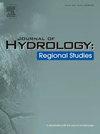The potential effect of climate-change induced consecutive dry or wet years on the freshwater lens of a barrier island (Langeoog, Germany)
IF 5
2区 地球科学
Q1 WATER RESOURCES
引用次数: 0
Abstract
Study region
Barrier island Langeoog at the German North Sea coast
Study focus
Due to climate change it is predicted that extreme weather events such as droughts and floods will occur more often in future. Since such events strongly influence the groundwater recharge, they will likely affect the freshwater volume on many small barrier islands. This is critical where freshwater lenses are the only source of drinking water. Groundwater abstraction for drinking water supply also influences the freshwater volume. To investigate the potential near-future climate change impacts, the influence of consecutive dry or wet years on the freshwater lens combined with several pumping scenarios is calculated using a density-dependent groundwater flow and transport model. Chosen sub-annual recharge and pumping rates are based on values from the past and, therefore, considered realistic for the island.
New hydrological insights for the region
Five extremely dry years would shrink the volume of the freshwater lens by 20 %. Extremely wet years cause flooding of large areas in the island interior. As the water table adjusts fast to new recharge conditions, flooding within the second winter is almost as severe as in the fifth winter. Tides and storm surges at the mesotidal coast have a great impact on the freshwater lens by constraining the area where fresh groundwater develops and affecting the water table in the interior of the island.
气候变化引起的连续干湿年对堰洲岛淡水透镜体的潜在影响(朗格,德国)
研究区域德国北海海岸的屏障岛兰格研究重点由于气候变化,据预测,干旱和洪水等极端天气事件将在未来更频繁地发生。由于这些事件强烈影响地下水补给,它们可能会影响许多小堰洲岛的淡水量。在淡水透镜是唯一饮用水来源的地方,这一点至关重要。抽取地下水供应饮用水也会影响淡水量。为了研究近未来气候变化的潜在影响,利用依赖于密度的地下水流量和输送模型,计算了连续干湿年对淡水透镜体的影响,并结合了几种抽水情景。所选择的次年补给和抽水速率基于过去的值,因此被认为对该岛来说是现实的。对该地区水文的新认识——极端干旱的5年将使淡水透镜体的体积缩小20% %。极端潮湿的年份导致岛屿内陆大片地区发生洪水。由于地下水位迅速适应新的补给条件,第二个冬天的洪水几乎和第五个冬天一样严重。中潮汐海岸的潮汐和风暴潮通过限制淡水地下水发育的区域和影响岛屿内部的地下水位对淡水透镜体产生了很大的影响。
本文章由计算机程序翻译,如有差异,请以英文原文为准。
求助全文
约1分钟内获得全文
求助全文
来源期刊

Journal of Hydrology-Regional Studies
Earth and Planetary Sciences-Earth and Planetary Sciences (miscellaneous)
CiteScore
6.70
自引率
8.50%
发文量
284
审稿时长
60 days
期刊介绍:
Journal of Hydrology: Regional Studies publishes original research papers enhancing the science of hydrology and aiming at region-specific problems, past and future conditions, analysis, review and solutions. The journal particularly welcomes research papers that deliver new insights into region-specific hydrological processes and responses to changing conditions, as well as contributions that incorporate interdisciplinarity and translational science.
 求助内容:
求助内容: 应助结果提醒方式:
应助结果提醒方式:


